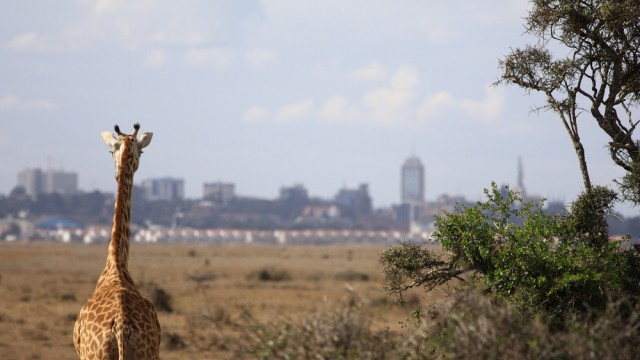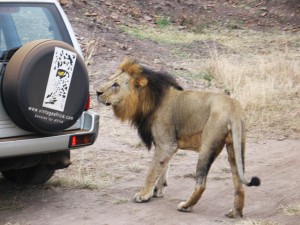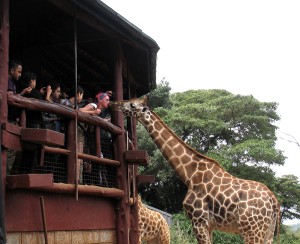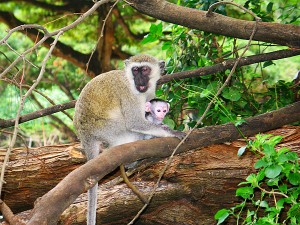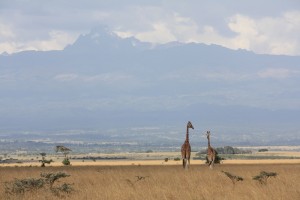Millions of people flock to Kenya every year to see its famous animals. They are the headline attraction, and draw those seeking a chance to go on safari and see the “Big Five” — elephants, lions, Cape buffalo, rhinoceroses and leopards — in iconic game reserves such as the Maasai Mara or Amboseli.
But if you’re visiting the country on business, or just spending a few days on a “city break” and can’t spare a few days for a full-scale safari experience, it’s still possible to see wildlife. There are numerous urban parks and sanctuaries located in and around the big cities, plus many lesser-known game reserves located within easy day-trip distance.
Urban Encounters
If you’re visiting Nairobi and don’t have the time to head out into the bush, you’ll find one of the best urban wildlife parks in the world just a few miles from the city’s Central Business District. All you need is a few hours, preferably in the morning, to see some of the 80 species of large mammals in the sanctuary known as the Nairobi National Park.
While I was in there, I saw giraffe, Cape buffalo, wildebeest, baboons, impala, a rhinoceros and her baby, and — most unexpectedly — a mating pair of lions (seems that’s an all-day on-again, off-again “dance”). During migrations, the variety of birds is amazing.
It’s somewhat disconcerting to look at gazelles while hearing the distant roar of big city traffic and seeing a line of skyscrapers on the northern edge of the park, but — this is Africa.
Go early: you want to be at the gate when it opens at 6:30 a.m., just as dawn is breaking. That’s when the animals are the most active, and you may even be able to spot an elusive leopard returning from a nocturnal hunt.
You can rent a car and drive yourself the six-plus miles to the nearest gate, but it’s much better to be driven in by one of the myriad safari companies in town (your hotel will be able to recommend one). The roads inside the park aren’t paved, and there are few directional signs; you don’t want to get lost on a pot-holed dirt road with a couple of flat tires!
Your time will be better spent as a passenger with a guide who’s been there often (and has a CB radio to share animal spotting with the other guides in the park), and you’ll be in a four-wheel-drive vehicle with an open top so you can see everything (and take a million photographs).
Two other places to see animals up close near Nairobi are the David Sheldrick Wildlife Trust and the AFEW Giraffe Center. The Sheldrick operates an orphanage for elephants, most of whose mothers were killed by poachers intent on bagging ivory. Twenty-four were in residence when I was there, most of whom were less than four years old.
For just one hour a day — from 11 a.m. until noon — the handlers bring the toddlers into an open area near the visitor center for their daily mud bath. One of the keepers provides running commentary on where the elephants come from (each has a name, of course) and what their daily routine is like. The babies stay at the orphanage for five or 10 years (depending on the animal), with the goal of return them to the wild in Tsavo National Park.
It’s true, however, that elephants do remember. The keepers tell of former charges who have made their way back to the park to show off their own babies, or maybe cadge some medical attention.
If you sign up to adopt an elephant, you’ll be able to come to a special viewing between 5 and 6 p.m. each day.
The Giraffe Center, which is just a short distance away from Sheldrick, is run by the African Fund for Endangered Wildlife (AFEW). A viewing platform takes visitors up to eyeball level with the gentle creatures, where you can pet and feed them. Entrance fees fund giraffe conservation and education for Kenyan school children.
If you’re near Mombasa, Haller Park is a relatively easy place to get up close and personal with critters. Just five miles (8km) northeast of downtown, it’s a small wildlife refuge that’s the result of a successful effort by the massive Bamburi Cement Factory to replant its former quarry. Regular feeding times draw tourists to three sets of rescued animals brought there — hippopotamuses, giraffes and crocodiles. The first two herbivores are uneventfully fed pellets that look like dog chow, while the crocs become unwitting entertainment as they leap out of the water to snap at pieces of raw chicken sent out over the river on a rope pulley.
Shimba Hills National Reserve is a little further afield than Haller (about 33 miles/54km southwest), but also well worth visiting. Water lilies, water birds and monkeys are the main draw here, but if the air is clear, you can see all the way to Mount Kilimanjaro to the west, and the Indian Ocean to the east. It’s one of the least-visited parks in Kenya, so you won’t run into busloads of tourists here.
Day Trips
If you are prepared to go a little further afield, consider a day trip to one of the 54 national parks and game preserves scattered throughout Kenya. Many are within two to three hours driving distance from Nairobi or Mombasa; your hotel can put you in touch with safari outfitters that offer excursions.
It’s about 122 miles to Aberdare National Park, which is a couple of hours’ drive north of Nairobi. This park is a “must stop” for birders (250+ species), although it also includes black rhinos, elephants, baboons, black leopards and other wildlife in its strikingly varied landscape including mountain peaks, ravines, waterfalls. This high-altitude park is unusual because it was created primarily to protect the moorland and slopes of the Aberdare Mountains, rather than the wildlife.
Tsavo West National Park, which I mentioned earlier, is not only home to former foster elephants, but is also known for its hippos, who love the pools of Mzima Springs. it’s one of the largest reserves in Kenya, and has a large number of lions, cheetahs and hartebeest as well. Chicagoans may get a ping of recognition at the name: During the construction of the Mombasa-Kampala railroad, a pair of lions in the Tsavo region killed and ate up to 135 Indian railway workers. The lions now reside, taxidermied of course, in the Field Museum. (The 1996 movie “The Ghost in the Darkness” was based on this incident.) Located halfway between Nairobi and Mombasa, it’s a three-hour drive from either city.
Mount Kenya, the second highest peak in Africa, is the centerpiece of Mount Kenya National Park. The main draw is the great hiking trails, from you can see some of the Big Five, but also more unusual animals, such as giant forest hogs, tree hyrax (a large rodent-like mammal), white-tailed mongoose, suni (a very small antelope), blackfronted duikers, mole-rats and over 130 species of bird. This park is also three hours from Nairobi.
Directly south of Nairobi is another kind of park. Olorgesailie Prehistoric Site was inhabited by pre-humans a half-million years ago and was extensively excavated by the legendary anthropologists Mary and Louis Leakey in the 1940s. Though it’s mainly known for the pre-historic human tools and fossils that were found there, it’s also a haven for birds, giraffes, and other ungulates (hoofed mammals).
